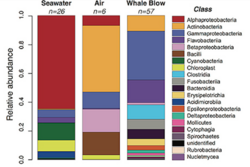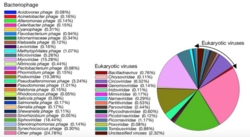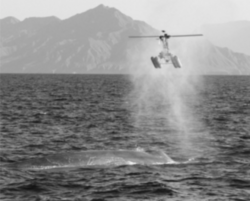Cetacean microbiome
Topic: Biology
 From HandWiki - Reading time: 7 min
From HandWiki - Reading time: 7 min
The cetacean microbiome is the group of communities of microorganisms that reside within whales.
Microbiomes play an important role in individual health and ecology and in particular in the discovery of different microbiomes in gut, skin and nose permitted to analyze their conditions and the condition of the marinMicrobiomee environment in which they live.
Gut
The access of microbial samples from the gut out of marine mammals is limited because most species are rare, endangered, and deep divers. There are different techniques for sampling the cetacean's gut microbiome. The most common is collecting fecal samples from the environment and taking a probe from the center that is non-contaminated.[1] Besides there are studies from rectal swabs and rare studies from stranded dead or living animals direct from the intestine.[2][3][4]
The intestinal microbiome of Cetaceans is a complex ecosystem that plays an important role in the metabolism, health, and immunity of the host.[5] The microbial communities of marine mammals are diverse and distinct from terrestrial mammals, and the community depends on different factors like kind of diet, phylogeny, health, and age.[3]
As the microbiome is involved in the decomposition of food, diet is a predominant factor for the microbial community. Different studies have shown that members of Bacteroidetes and Firmicutes are the most abundant phyla of gut microorganisms in animals that are cephalopod predators or zooplankton predators like in short-finned pilot whales and baleen whales.[4][6] Especially the genus Bacteroides (phyla Bacteroidetes) seems to play a major role in the decomposition of the chitin-rich diet of these species and were also found in the gut microbiome of baleen whales.[6]
In toothed cetacean species which food consumption is mainly piscivore the most abundant phyla are Firmicutes, Fusobacteria, and Proteobacteria.[7] Proteobacteria are classified as a minor important group for marine mammals that consume cephalopods and zooplankton but are highly abundant in piscivorous predators like bottlenose dolphins, East Asian finless porpoises, and belugas. These findings could mirror the different dietary niches of these species.[8]
Besides the dietary also the age seems to determine the differences in the microbial community between cetaceans. Maron et al. have shown that the microbial community is changing in right whale caves during their development. Interestingly the genera Bilophila, Peptococcus, and Treponema are more abundant in older calves. The higher abundance of Bilophila might be a response to the greater milk intake of the older calves.[9]
Skin
The skin is the first barrier that protects the individual from the outside world and the epidermal microbiome on it is considered an indicator not only of the health of the animal but is also considered an ecological indicator that shows the state of the surrounding environment. Knowing the microbiome of the skin of marine mammals under ''normal'' conditions has allowed us to understand how these communities are different from the free microbial communities found in the sea and how they can change according to abiotic and biotic variations, and also ''communities vary between healthy and sick individuals''.[10]
Different studies on migratory marine mammals in particular Megaptera novaeangliae, killer whales, Orcinus orca, and Beluga whales, which are exposed to different habitats host different communities of Bacterioplankton [10] and in many cases diatoms growing on the backs of migrating killer whales.[11]
Although studies on the microbiome of the skin of these marine mammals are quite limited, thanks to the amplification of SSU rRNA genes, were discovered communities belonging to the phylum Bacteroidetes, in particular of the family Flavobacteriaceae, the genus Tenacibaculum dicentrarchi, and it seems that the role of these bacteria is to regulate the microbiome present on the skin of marine mammals, acting as predators and limit the exponential growth of other communities.[10][12]
Another type of bacterium found on the skin of cetaceans is Phychrobacter, able to tolerate low temperatures and therefore present during migratory routes to high latitudes, it was also discovered that this bacterium is one of those controlled by T. dicentrarchi; while in skin lesions the bacterium spp. Moraxella was found, but not only also in healthy skin such as blowholes and mouths of dolphins [12]
It is not well known whether these communities of microorganisms are transient colonizers of the skin surface or have adapted to that environment, thus subjecting themselves to variations in extrinsic and intrinsic factors that go to change the communities of the skin microbiome, such as UV rays, skin detachment, which seems to be involved in the change of the microbial communities, the change of pressure and temperature, which influences a regional and temporal variability of the skin microbiome, the sex, the age and the health status of the individual, all influence the microbiome and the change of the skin communities. In conjunction with these factors, climate change has been shown to further influence the growth and presence of certain bacterial communities as well as the health status of these cetaceans.[13]
Respiratory system


Impact of cetacean respiratory system microbiome
The cetaceans are in danger because they are affected by multiple stress factors, especially anthropogenature, which make them more vulnerable to various diseases. These animals have been noted to show high susceptibility to airway infections, but very little is known about their respiratory microbiome. Therefore, the sampling of the exhaled breath or "blow" of the cetaceans can provide an assessment of the state of health. Blow is composed of a mixture of microorganisms and organic material, including lipids, proteins , and cellular debris derived from the linings of the airways which, when released into the relatively cooler outdoor air, condense to form a visible mass of vapor, which can be collected. There are various methods for collecting exhaled breath samples, one of the most recent is through the use of aerial drones. This method provides a safer, quieter, and less invasive alternative and often a cost-effective option for monitoring fauna and flora. The use of aerial drones has been more successful with large cetaceans due to slow swim speeds and larger blow sizes.[15][17][18][19][20][14][21][22][16]
In all the studies carried out, in addition to exhaled breath samples, seawater and air samples were collected to more accurately identify the specific microorganisms for exhaled breath.
Through various studies carried out on different cetaceans, among which, Humpback whales (Megaptera novaeangliae),[15][17][18][16] Blue whale (Balænoptera musculus),[14] Gray whale (Eschrichtius robustus),[14] Sperm whale (Physeter macrocephalus),[14] Killer whale ( Orcinus orca) [21] and bottlenose dolphins (Tursiops truncatus),[19][20][22] the respiratory microbiome has begun to be defined, i.e., a microbial community formed by a complex diversity of common microorganisms to all the specimens examined. These are very recent studies, so knowledge is very limited, only some microorganisms are known while others have not yet been identified and little is known about their functional role within these animals. Overall, the most common bacteria identified at the phylum level included Pseudomonadota, Bacillota, Actinomycetota, and Bacteroidota.
Types of bacteria found in the respiratory systems of cetaceans
Among the Pseudomonadota, bacteria belonging to the families Brucellaceae and Enterobacteriaceae and to the genera "Candidatus Pelagibacter", Acidovorax, Cardiobacterium, Pseudomonas, Burkholderia, and Psychrobacter have been recognized.
Among the Bacillota, bacteria belonging to the Clostridia and Erysipelotrichia classes and to the genera Anoxybacillus, Paenibacillus and Leptotrichia have been recognized.
Bacteria belonging to the Acidimicrobiia class, to the Microbacteriaceae family, and to the genera Corynebacterium, Mycobacterium and Propionibacterium (Cutibacterium), have been recognized among the Actinomycetota.
Among the Bacteroidota, bacteria belonging to the genus Tenacibaculum have been recognized.
To these are added bacteria belonging to the phylum Fusobacteriota and Mycoplasmatota.
Finally, potential respiratory pathogens were also detected, such as Balneatrix (proteobacteria) and a range of Gram-positive Clostridia and Bacilli, such as Staphylococcus and Streptococcus (both firmicutes). Furthermore, one of the most common bacteria in the various cetacean species is the Haemophilus bacterium. These are opportunistic gram-negative coccobacilli, also found in the respiratory tract of humans and other animals, which tend to colonize but without causing the onset of infection. But during periods of immunosuppression these organisms can cause damage by generating meningitis and pneumonia.[14]
In addition to bacteria, some viruses have also been identified in whale exhaled breath. Among the most abundant bacteriophages were the Siphoviridae and Myoviridae, while among the viral families there were small single-stranded DNA viruses (ss), in particular the Circoviridae, members of the Parvoviridae , and a family of RNA viruses, the Tombusviridae.[16]
References
- ↑ "Fecal microbiota of captive Antillean manatee Trichechus manatus manatus". FEMS Microbiology Letters 366 (11). June 2019. doi:10.1093/femsle/fnz134. PMID 31210263.
- ↑ "Microbiome Composition and Function in Aquatic Vertebrates: Small Organisms Making Big Impacts on Aquatic Animal Health". Frontiers in Microbiology 12: 567408. 2021. doi:10.3389/fmicb.2021.567408. PMID 33776947.
- ↑ 3.0 3.1 "Marine mammals harbor unique microbiotas shaped by and yet distinct from the sea". Nature Communications 7: 10516. February 2016. doi:10.1038/ncomms10516. PMID 26839246. Bibcode: 2016NatCo...710516B.
- ↑ 4.0 4.1 "Microbial diversity and structure in the gastrointestinal tracts of two stranded short-finned pilot whales (Globicephala macrorhynchus) and a pygmy sperm whale (Kogia breviceps)". Integrative Zoology 16 (3): 324–335. May 2021. doi:10.1111/1749-4877.12502. PMID 33174288.
- ↑ "Comparative analysis of microbial community structure between healthy and Aeromonas veronii-infected Yangtze finless porpoise". Microbial Cell Factories 19 (1): 123. June 2020. doi:10.1186/s12934-020-01383-4. PMID 32503532.
- ↑ 6.0 6.1 "Baleen whales host a unique gut microbiome with similarities to both carnivores and herbivores". Nature Communications 6: 8285. September 2015. doi:10.1038/ncomms9285. PMID 26393325. Bibcode: 2015NatCo...6.8285S.
- ↑ "The intestinal microbiome of an Indo-Pacific humpback dolphin (Sousa chinensis) stranded near the Pearl River Estuary, China". Integrative Zoology 16 (3): 287–299. May 2021. doi:10.1111/1749-4877.12477. PMID 32761739.
- ↑ "Microbial communities in different regions of the gastrointestinal tract in East Asian finless porpoises (Neophocaena asiaeorientalis sunameri)". Scientific Reports 8 (1): 14142. September 2018. doi:10.1038/s41598-018-32512-0. PMID 30237562. Bibcode: 2018NatSR...814142W.
- ↑ "Symbiotic microbes and potential pathogens in the intestine of dead southern right whale (Eubalaena australis) calves". Anaerobe 57: 107–114. June 2019. doi:10.1016/j.anaerobe.2019.04.003. PMID 30959166.
- ↑ 10.0 10.1 10.2 "Humpback whales harbour a combination of specific and variable skin bacteria". Environmental Microbiology Reports 3 (2): 223–232. April 2011. doi:10.1111/j.1758-2229.2010.00213.x. PMID 23761254.
- ↑ "Host-derived population genomics data provides insights into bacterial and diatom composition of the killer whale skin". Molecular Ecology 28 (2): 484–502. January 2019. doi:10.1111/mec.14860. PMID 30187987.
- ↑ 12.0 12.1 "Temporal and Regional Variability in the Skin Microbiome of Humpback Whales along the Western Antarctic Peninsula" (in EN). Applied and Environmental Microbiology 84 (5). March 2018. doi:10.1128/AEM.02574-17. PMID 29269499. Bibcode: 2018ApEnM..84E2574B.
- ↑ Geographic Influences on the Skin Microbiome of Humpback Whales (Report). 21 April 2016. https://dukespace.lib.duke.edu/dspace/bitstream/handle/10161/11830/Bierlich_MP.pdf.
- ↑ 14.0 14.1 14.2 14.3 14.4 14.5 "A novel non‐invasive tool for disease surveillance of free‐ranging whales and its relevance to conservation programs.". Animal Conservation 13 (2): 217–225. April 2010. doi:10.1111/j.1469-1795.2009.00326.x.
- ↑ 15.0 15.1 15.2 "An economical custom-built drone for assessing whale health.". Frontiers in Marine Science 4: 425. December 2017. doi:10.3389/fmars.2017.00425.
- ↑ 16.0 16.1 16.2 16.3 "Virological Sampling of Inaccessible Wildlife with Drones". Viruses 10 (6): 300. June 2018. doi:10.3390/v10060300. PMID 29865228.
- ↑ 17.0 17.1 "Extensive Core Microbiome in Drone-Captured Whale Blow Supports a Framework for Health Monitoring". mSystems 2 (5). 2017. doi:10.1128/mSystems.00119-17. PMID 29034331.
- ↑ 18.0 18.1 "Interannual comparison of core taxa and community composition of the blow microbiota from East Australian humpback whales". FEMS Microbiology Ecology 95 (8). August 2019. doi:10.1093/femsec/fiz102. PMID 31260051.
- ↑ 19.0 19.1 "Novel diversity of bacterial communities associated with bottlenose dolphin upper respiratory tracts". Environmental Microbiology Reports 1 (6): 555–62. December 2009. doi:10.1111/j.1758-2229.2009.00080.x. PMID 23765934.
- ↑ 20.0 20.1 "The use of Unmanned Aerial Vehicles (UAVs) to sample the blow microbiome of small cetaceans". PLOS ONE 15 (7): e0235537. 2020. doi:10.1371/journal.pone.0235537. PMID 32614926. Bibcode: 2020PLoSO..1535537C.
- ↑ 21.0 21.1 "Respiratory Microbiome of Endangered Southern Resident Killer Whales and Microbiota of Surrounding Sea Surface Microlayer in the Eastern North Pacific". Scientific Reports 7 (1): 394. March 2017. doi:10.1038/s41598-017-00457-5. PMID 28341851. Bibcode: 2017NatSR...7..394R.
- ↑ 22.0 22.1 "Temporal stability and species specificity in bacteria associated with the bottlenose dolphins respiratory system". Environmental Microbiology Reports 4 (1): 89–96. February 2012. doi:10.1111/j.1758-2229.2011.00306.x. PMID 23757234.
 |
 KSF
KSF
